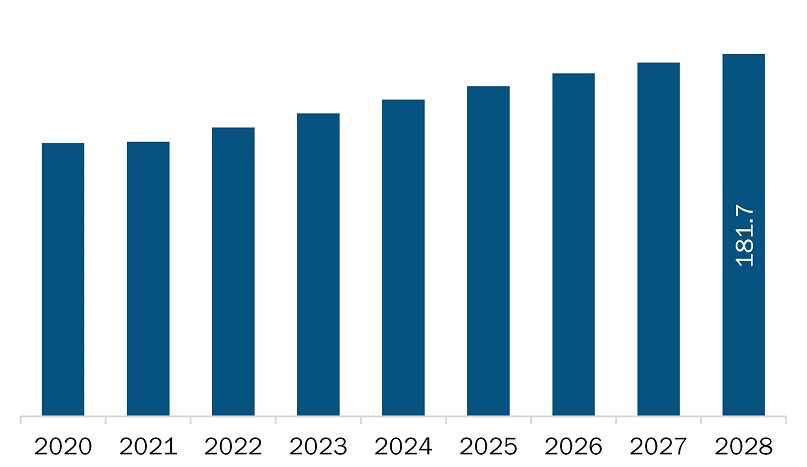The South and Central America fiber optic sensor market is expected to reach US$ 181.7 million by 2028 from US$ 137.7 million in 2021. The market is estimated to grow at a CAGR of 4.0% from 2021–2028.
Various governments are taking initiatives to propel the development of smart cities in their respective economies. In March 2021, Optromix, Inc. announced fiber optic sensors that can be installed as a component of smart transport. The company is engaged in providing intelligent traffic analysis and route planning services in large cities. These services are based on fiber optic solutions for the collection and processing of vehicle movement data. Thus, the growth in such efforts to develop smart cities are providing significant opportunities for the growth of the fiber optic sensor market players.
South American countries have been witnessing growth in number of industries over the past few years. Industries such as oil & gas, infrastructural, and manufacturing industry equipment have been experiencing fair growth rate; however, the COVID-19 outbreak has created significant turmoil among the manufacturers across industries. Brazil has the highest number of COVID-19 cases, followed by Peru, Chile, Colombia, and Ecuador, among others. The government of South America has taken an array of actions to protect their citizens and contain COVID-19’s spread. Brazil has the largest industrial sector and is also the worst-hit country. This has been highlighting limited resources and investments toward product developments, which has slow-downed the adoption of fiber optic sensors. This factor has negatively impacted the fiber optic sensors market.
With the new features and technologies, vendors can attract new customers and expand their footprints in emerging markets. This factor is likely to drive the fiber optic sensor market. The South and Central America fiber optic sensor market is expected to grow at a good CAGR during the forecast period.

- This FREE sample will include data analysis, ranging from market trends to estimates and forecasts.
South and Central America Fiber Optic Sensor Market Segmentation
By Vertical
- Oil & Gas
- Manufacturing
- Infrastructure
- Power and Utilities
- Others
By Application
- Temperature Sensing
- Pressure Sensing
- Acoustic Sensing
- Strain Sensing
- Others
By Country
- South and Central America
-
-
-
- Brazil
- Argentina
- Rest of South and Central America
-
-
Companies Mentioned
- Omnisens SA
- Solifos AG
- Baumer Holding AG
- Keyence Corporation
- OMRON Corporation
- Luna Innovations Inc.
- SICK AG
- Yokogawa Electric Corporation
South and Central America Fiber Optic Sensor Report Scope
| Report Attribute | Details |
|---|---|
| Market size in 2021 | US$ 137.7 Million |
| Market Size by 2028 | US$ 181.7 Million |
| CAGR (2021 - 2028) | 4.0% |
| Historical Data | 2019-2020 |
| Forecast period | 2022-2028 |
| Segments Covered |
By Application
|
| Regions and Countries Covered |
South and Central America
|
| Market leaders and key company profiles |
|
- Historical Analysis (2 Years), Base Year, Forecast (7 Years) with CAGR
- PEST and SWOT Analysis
- Market Size Value / Volume - Regional, Country
- Industry and Competitive Landscape
- Excel Dataset
Recent Reports
Testimonials
Reason to Buy
- Informed Decision-Making
- Understanding Market Dynamics
- Competitive Analysis
- Identifying Emerging Markets
- Customer Insights
- Market Forecasts
- Risk Mitigation
- Boosting Operational Efficiency
- Strategic Planning
- Investment Justification
- Tracking Industry Innovations
- Aligning with Regulatory Trends





















 Get Free Sample For
Get Free Sample For